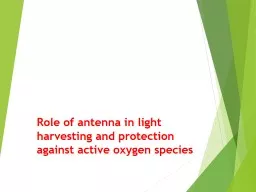

Introduction In photosynthetic eukaryotic organisms have sub cellular structure known as chloroplast a prime site of photosynthesis The chloroplast have thylakoids a special structure where light ID: 919136
Download Presentation The PPT/PDF document "Role of antenna in light harvesting and ..." is the property of its rightful owner. Permission is granted to download and print the materials on this web site for personal, non-commercial use only, and to display it on your personal computer provided you do not modify the materials and that you retain all copyright notices contained in the materials. By downloading content from our website, you accept the terms of this agreement.
Slide1
Role of antenna in light harvesting and protection against active oxygen species
Slide2Introduction
In photosynthetic eukaryotic organisms have sub cellular structure known as chloroplast a prime site of photosynthesis.The chloroplast have thylakoids a special structure where light reaction of photosynthesis takes place.The thylakoid membrane is known as fret channel where a group of chlorophylls are present as photosystems.The thylakoids are of two types:Stromal lamellaeGrana lamellae
Slide3The membrane of thylakoid contain wide variety of proteins/ pigments
responsible for photosynthesis are embedded in thylakoid membranes.These pigments are reaction centers, the antenna pigment-protein complexes and electron carrier proteins located in integral membrane so called integral membrane proteins.The chlorophylls and accessory light harvesting pigments are associated with non covalent bond in a specific manner and form antenna molecules or pigment-protein complexes.Antenna molecules and reaction center chlorophylls are associated with membrane proteins and form photosystems.
Slide4Antenna complex
The antenna complex (or light-harvesting complex) is an array of protein and chlorophyll molecules embedded in the thylakoid membrane (Fret channels) of chloroplast in plants and cyanobacteria. Antenna complex use to transfer light energy to one specialized chlorophyll molecule known as reaction center (P700 or P680) of a photosystem.
Slide5Photosystems
Photosystems (PS) are the group of pigments works as a functional unit present in two distinct groups called photosystems or pigment systems (I and II). Each PS contains 250 – 400 pigment molecules. They are divided into three types.Reaction centerCore moleculesAntenna molecules
Harvesting
pigments/molecules
Slide6Photosystem
Slide7Photosystems I
Photosystem I (PS I) have a special chlorophyll showed as P700. PS I have more chlorophyll a while chlorophyll b and carotenoids are in less amount present in antenna molecules.PS I present in stromal and non-pressed part of grana thylakoids. It generates the reducing power for the reduction of NADP+
to
NADPH using NADP dehydrogenase.
Slide8Photosystems II
Photosystem II (PS II) have a special chlorophyll showed as P680. They have chlorophyll a and chlorophyll b content are equal and carotenoids are
much more than chlorophyll
present in antenna molecules.
PS I present in
pressed
part of
granal
thylakoids.
It
receive electrons from splitting of water molecules also involved in ATP synthesis.
Slide9Diagram showing different complexes
PS I: Photosystem IPS II: Photosystem IILHC: light harvesting complexCytob6f: cytochrome b6f complex
Slide10Role of the Antenna in Photosynthesis
:All photosynthetic pigments (reaction center or the antenna) are capable of direct absorption of sunlight. During normal light intensities, the rate of light absorption by a reaction center pigment alone is far below the capacity for photosynthetic electron transport and would not provide sufficient energy to drive the process.Therefore, efficient photosynthesis is only possible when energy of photons of various wavelengths is captured over a certain surface comprising hundred of antenna pigments.Since the accessory pigments such as Chl b and carotenoids belong to the antenna and absorb wavelengths of light which are only weakly absorbed by Chl a, the range of wavelengths over which the light absorption can occur becomes wider, thus improving the efficiency of light absorption.
Slide11Protection against Active Oxygen Species:
The excited singlet state of
chl
a which forms by light absorption is unstable and will decay back to the lowest energy (ground state) by means of three intrinsic processes.
These are intersystem crossing to the triplet state, radiation decay (fluorescence) and thermal emission (heat). The yield of triplet
Chl
in the antenna far exceeds that produced in the reaction center. The triplet state of
Chl
a can sensitize the formation of an excited singlet state of oxygen (
1
O
2
) via triplet energy transfer.
3
Chl*
+ O
2
→
Chl
+
1
O
2
The singlet oxygen produced is highly reactive and can oxidize many important biological molecules, particularly lipids. In all photosynthetic organisms, this problem is overcome by the presence, in the antenna complexes, of carotenoids which rapidly quench
Chl
triplet states.
Slide12The quenching reaction involves the triplet energy transfer from
Chl a to the carotenoid followed by thermal dissipation of the triplet energy on the carotenoid.3Chl* + carotenoid → Chl + 3
carotenoid* →
Chl
+ carotenoid +
heat
In
addition, carotenoids can quench singlet oxygen directly through a similar triplet transfer reaction
.
1
O
2
+ carotenoid → O
2
+
3
carotenoid* → O
2
+ carotenoid +
heat
Thus, the carotenoid in photosynthetic antennae play the essential role of photo-protection by preventing the formation and accumulation of singlet O
2
.
This is the reason why plants without carotenoids cannot grow and survive in strong light conditions.